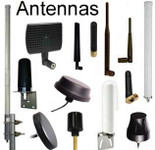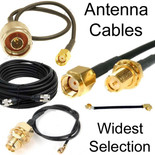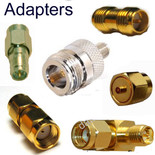Antennas, Antenna Cables, Wireless Products: Technical Articles
U.FL connector Popping Off Jack on PCBA: How to Solve
Table of Contents
Most likely solutions: These solutions work for IPEX as well as U.FL connectors.
- Use U.FL retention clip to hold the U.FL connector on the jack.
- Use the U.FL press /pull tool (flat tip) during installation.
- Use slightly longer U.FL cable assembly to allow more slack.
U.FL connector failure analysis & menu of fixes
Solutions for U.FL connector popping off the board jack during installation, assembly or handling.
U.FL/MHF connectors are snap-fit, low-retention, low-profile parts designed for internal RF jumpers with very little side-load, few mate/unmate cycles, and strict cable routing. When process or layout violates those constraints, they disconnect.
Likely root causes (ranked by frequency)
- Incomplete or misaligned mating
- Plug isn’t fully “clicked” onto the jack (off-axis press, tweezers at an angle, or pressing on the cable not the ferrule).
- Visuals: plug sits slightly high; no positive “click”; easy to flick off with light touch.
- Wrong or mixed series
- “U.FL-compatible” ≠ “identical.” Mixing I-PEX MHF variants (MHF4/MHF4L/MHF5) with Murata U.FL/Hirose W.FL jacks can reduce retention height/force. It may work electrically but is mechanically fragile.
- Side-loading during downstream assembly
- Short 55 mm lead + 1.37 mm coax stiffness puts peel torque on the joint when boards are placed into housings, rotated, or when nearby harnesses are tied down.
- No local strain relief
- Cable exits the plug and immediately bends; any touch, lid install, or tool bump pries the plug upward.
- Board/jack issues
- Jack not perfectly coplanar after reflow, solder voiding on the ground tabs, or board flex near the connector during screw-down causes micro-lift → easy disconnect.
- Over-handling / cycling
- These connectors are typically rated for ~10–30 cycles (series-dependent). Trial fits during debug quickly consume the rating and loosen the snap.
Immediate containment (no BOM change)
- Mating process
- Use the U.FL press /pull tool (flat tip) and press straight down on the plug body until a tactile click.
- Add 100% visual check: the plug shoulder should sit flush with the jack; no gap.
- Prohibit pressing on the cable or at an angle. Add a one-line work instruction with a photo.
- Temporary retention
- After mating, apply a retention clip.
- Alternative: foam pad or tie-down that gently compresses the cable against the PCB or housing wall to neutralize peel.
- Cable dressing
- Add 5–10 mm of slack and route the first bend in the plane of the PCB (no upward bend within 10 mm of the jack).
- If 55 mm is taut, test a 65–80 mm length to form a shallow loop.
- Do not cycle
- Lock the design; no trial mate/unmate on production units.
Short-term engineering improvements (low impact)
- Strain-relief near the plug
- Add a stick-on cable anchor (micro tie-base or tape) within 10–15 mm of the jack to redirect forces into the PCB, not the snap joint.
- Consider a short heat-shrink boot (over the plug tail and first 8–10 mm of cable) to reduce sharp kinks (avoid covering the latch line).
- Slightly softer cable
- If mechanicals allow, 1.13 mm micro-coax is more flexible than 1.37 mm and reduces peel torque. Electrical loss increases slightly—verify link budget.
- QC pull test (screen only)
- After mating, use a light vertical tug test (e.g., 1–2 N) to confirm positive latch without risking damage. Do not do repeated full pull-offs.
Medium-term BOM / design changes (best reliability)
- Match connector series 1:1
- Confirm the exact jack series on the customer PCB (e.g., I-PEX MHF4 vs Murata U.FL-R-SMT). Provide plugs from the same series/brand with the correct mating height. Cross-brand “compatible” can work electrically but mechanical retention can be materially lower.
- Higher-retention variant
- Where available, migrate to I-PEX “MHF… with lock/retainer” hardware or a jack with a metal hold-down frame. Some series offer Secure-Lok/retainer clips that add a mechanical latch without changing RF geometry.
- Connector relocation
- Move the jack away from board edges / screw posts and add keep-out so fingers/tools can press straight down; add stiffener or support post under the jack area to limit board flex.
- Right-angle choice
- If the current jack is vertical and the cable must bend immediately, use a right-angle jack so the cable exits in-plane and doesn’t pry upward.
Checklist for diagnosis and solution
- Confirm series compatibility: Find the jack manufacturer & series and use plugs from the matching series.
- Try longer sample lengths (by 1/4 inch to 1/2 inch or 10 mm) to find the minimum slack that stops pop-offs in your PCB assembly.
- Add near-connector heat-shrink boot and adhesive Kapton tabs.
- Add a retention clip on each connector.
Quick diagnostic checklist (5-minute triage)
- Is the plug flush to the jack (no visible gap)?
- Does it pop off when the cable is nudged sideways or when the housing is placed?
- What is the jack brand/series on the PCB? (photo + BOM reference)
- Is the first cable bend within 10 mm of the jack and upwards?
- Is the board flexing near the jack during screw-down?
Answering those five will point directly to process vs. mechanical vs. component-match fix.
Bottom line
This is a mechanical retention problem typical of micro-RF snap connectors under side-load or mixed-series mating. Start with process correction + small strain relief + a bit more slack, and in parallel verify exact series compatibility. If the unit still sees bumps during assembly, add a retaining adhesive/tape or move to a higher-retention jack/retainer.
FAQs
Why does a U.FL connector pop off the jack on a PCB?
The most common reasons include incomplete or misaligned mating, side-loading from tight cable routing, mixed connector series (e.g., MHF vs. U.FL), lack of strain relief, or board/jack misalignment after solder reflow. U.FL and I-PEX MHF connectors are designed for light internal RF use, so any side force or improper fit can easily cause disconnection.
How can I prevent a U.FL connector from popping off?
Use a U.FL retention clip to secure the connection, and always press straight down using a proper U.FL press/pull tool—never press on the cable. Add a bit of extra slack (5–10 mm) in the coax routing to reduce stress. Avoid bending the cable upward within 10 mm of the jack, and use strain-relief anchors or foam pads to stabilize the cable during assembly.
Can mixed U.FL and I-PEX MHF connectors cause mechanical failure?
Yes. “U.FL-compatible” doesn’t always mean identical. Mixing Murata U.FL, Hirose W.FL, and I-PEX MHF series (such as MHF4 or MHF5) may create a connection that works electrically but lacks the correct retention height or latch strength, leading to easy pop-offs. Always match the plug and jack brand and series 1:1.
What are low-impact fixes if redesign isn’t possible?
You can implement quick containment actions without changing the BOM:
- Use retention clips or foam pads to stabilize the connector.
- Add heat-shrink boots or adhesive tabs near the plug for strain relief.
- Perform a light pull test (1–2 N) after assembly to confirm a solid latch.
- Ensure a visual check confirms that the plug sits flush—no visible gap.
What design changes improve long-term reliability?
For durable assemblies, use matching connector series, consider a right-angle jack to prevent upward bending, and move the connector away from board edges or screw posts to reduce flex. If available, choose a high-retention variant (e.g., I-PEX with Secure-Lok or retainer hardware). A short heat-shrink boot or softer 1.13 mm coax can also minimize peel torque.







